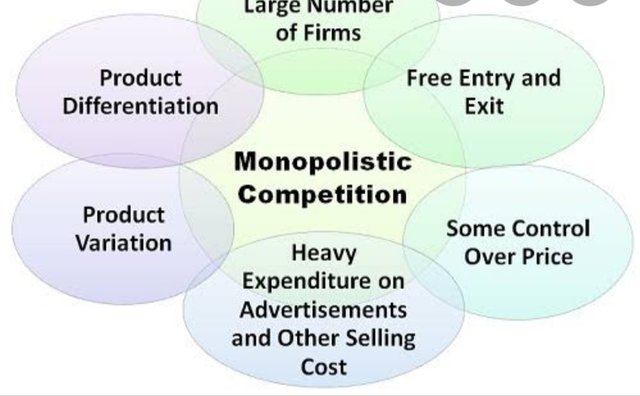Monopoly Competition in a Business
Monopolistic Competition
Meaning of Monopolistic Competition
Monopolistic Competition is defined as a market structure in which there are many
firms selling closely related but unidentical commodities. Examples: detergents,
automobiles, textiles, soft drinks, T.V. sets, etc.
 src
src
Features of Monopolistic Competition
The major features of monopolistic competition are:
(a)Large Number of Buyers and Sellers. There are a large number of buyers and sellers of
the commodity but not so large as in perfect competition. Each firm is supplying a small
percentage of total market supply of the product. As a result, a firm is in a position to
influence price of the product marginally on its own due to its brand value but not
because of big influence. Similarly no individual buyer can influence the price of the
product.
 src
src
(b)Product Differentiation. The products of the sellers
are differentiated but are close substitutes of one
another. Product differentiation can be real or
artificial. Its effect is that sellers can differentiate their
products. This gives the seller some degree of price-
making power, which he can exploit. But there are
many close substitutes for each product and thus, a
monopolistic firm faces an elastic demand curve
(c) Free Entry or Exit of Firms. Firms can freely move
in and out of a ‘group’. In monopolistic competition, the concept of industry is
undefined as products are differentiated. Instead of industry, the word ‘group’ should
be used.
(d) Imperfect Knowledge. Buyers and sellers do not have perfect or complete knowledge
of market conditions. Buyer’s preferences are guided by advertising and other selling
activities undertaken by the sellers.
(e)Selling Cost. A firm under monopolistic competition incurs selling cost which is the
cost of promoting the demand for its product. Examples of selling costs are
advertisements, window displays, salesmen’s salaries, etc. It plays a major role.
The advertisements either from print media or electronic media merely
persuade consumers to buy a particular brand of a product. Therefore, its aim is to lure
away customers from other brands of the product.
(f) High Transportation Cost. Cost of transporting the commodity from one place to
another is very high under monopolistic competition.
Monopolistic Competition vs. Monopoly
(a)Comparison of Assumptions
Monopoly Monopolistic Competition
- Single seller
- No close substitutes
- Barriers to entry
- Selling cost is zero
- Large number of buyers and sellers
- Differentiated products
- Free entry and exit
- Heavy selling cost are incurred
Conclusion of Perfect Competition, Monopolistic Competition, Oligopoly and Monopoly
In conclusion, the concept of market structure is central to both economics and marketing. Besides, there are difference feature in these four common types of market structure which is perfect competition, monopolistic competition, oligopoly and monopoly. Perfect Competition which is many sellers of a standardized product, Monopolistic Competition which has many sellers of a differentiated product, Oligopoly has few sellers of a standardized or a differentiated product, and Monopoly which is a single seller of a product for which there is no close substitute.
Conclusion of Monopoly
In conclusion, monopoly is only a seller but many buyers in a market. ... The seller is 'price maker', he decided to set the product price and maximize the profit. Therefore, monopoly is an absence of competition, which often results in high prices.
 src
src

@monz122 your content is very much knowledgeable....through your content I got to know more about monopoly...just keep writing....all the best 🌸
#onepercent
#bestofindia
@tipu curate
Upvoted 👌 (Mana: 8/20) Passive income with @tipU :)
Well written and quality write up you have done here